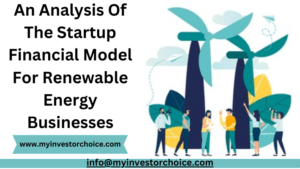 An Analysis Of The Startup Financial Model For Renewable Energy Businesses
An Analysis Of The Startup Financial Model For Renewable Energy Businesses
Introduction
Myinvestorchoice is a financial and business consulting firm that provides financial and business planning services to a variety of industries. This case study aims to highlight our engagement with a startup renewable energy business seeking assistance in developing a comprehensive 10-year financial model. We provided the client with accurate projections and insights to support their business planning and decision-making.
They needed a financial model to assess their startup’s renewable energy business’s feasibility and profitability and attract investors and stakeholders for debt and equity financing. The client’s business model involved extracting natural gas from landfill gas and then converting it into electricity. To assist the client in understanding the project’s financial feasibility, Myinvestorchoice developed a comprehensive financial model.
Client Background
The client is a startup that develops and operates a renewable energy business. The company concentrates on extracting natural gas from landfill gas and producing electricity to meet market demand at a lower cost. To determine the business’s feasibility and profitability, our client required a robust and dynamic financial model.
Business Objective
Client’s objective is to supply two megawatts of continuous, low-cost, renewable electricity to economically distressed rural areas in a US state annually. To determine the feasibility of attracting investment for the client’s proposed renewable energy projects, the financial model was utilized to evaluate the potential return on investment. Costs and benefits associated with each project would also be analyzed.
The Approach
Myinvestorchoice began by understanding the client’s business model, goals, and objectives. We conducted meetings with the management team to understand their current operations, plans, and challenges. As part of our initial consultation with our client, we collected essential information regarding their startup renewable energy business, operations, and financial objectives. Our goal was to understand their revenue streams, cost drivers, key performance indicators, production volume, payroll, and growth strategies. Our financial model was developed based on this understanding.
Complexity and challenges of the technical aspects
Complex revenue Streams
A thorough analysis of the revenue was required; it was necessary to identify the gas production, the percentage of recoverable gas, the gas bought, the heart rate, and the British Thermal Units per standard cubic foot (BTU/SCF).
Tax Credit Amount for Investments
It was requested by the client that the Investment Tax Credit benefits be incorporated into the model. There is a variation in the income tax credit percentage. Depending on the government’s requirements, it can range from 30% to 40% to 50%. Since the client met the 50% investment tax credit requirement, we incorporated a 50% investment tax credit. To calculate the investment tax credit percentage, we calculated the overall project cost, including turbine purchase cost, well infrastructure, and control systems.
Obtain equity and debt financing
There were no set criteria for how much investment (debt or equity) our client would seek. To run the business smoothly, he wanted us to determine how much investment he would require. Therefore, the investment from investors represents the sum of the expenses incurred from the start of the business. The owner is responsible for any expenses incurred before the commencement of operations.
Alternatives
As a result of our experts analyzing the Gas Production on a monthly and annual basis, we were able to estimate the revenue projection for the next ten years. Additionally, it includes the equivalency value and the price of renewable identification numbers (RINs).
Our client’s revenue projections were based on a detailed analysis of market demand, capacity utilization, and pricing dynamics. In addition, we considered factors such as the investment tax credit amount, which allowed the government to return 30%, 40%, and 50% of the capital amount, and have adjusted it in monthly tax payments if our client meets the requirements. Moreover, the selling price of services, gas capture, and control system costs are also evaluated.
Outcomes
Using our financial model, the client could predict and plan their financial performance for the next ten years. The model included projections of total revenue, expenses, and cash flow. It also included project evaluation, cash utilization, financial ratios, and breakeven analysis to evaluate the impact of different factors on the client’s financial performance.
The following financial statements and future projections demonstrate the details of the forecasted financial model.
Highlights of the financial year
Our financial model provides a comprehensive view of financial performance over 10 years. The report was composed of interconnected sheets, including an income statement, a balance sheet, a cash flow statement, and supporting schedules. For scenario analysis, the model incorporated dynamic formulas and inputs.
Sheet Of Inputs
Additionally, we conducted market research to identify growth rates, industry trends, and regulatory requirements. Based on this information, we developed a set of assumptions concerning revenue generation, expenses, capital investments, tax considerations, and funding sources.
Estimated Revenue
This transaction involves the sale of electrons, RINS (Renewable Identification Numbers), and carbon offsets. To estimate the equivalency values, heart rate, and price of carbon offsets and RINs, we conducted a detailed analysis of market trends, pricing dynamics, and regulatory frameworks.
In our capacity as Myinvestorchoice, we meticulously prepared revenue projections for our client’s startup renewable energy business, taking into account a variety of revenue sources. Our experts were able to incorporate the department-specific costs, OPEX, and payroll into the cost of sales after initial estimations and costs. Additionally, it includes the number of Landfill gas (LFG) productions bought and the total energy produced each month and year.
A Statement Of Income
Profit and loss statements provide an overview of the profitability of a company. our experts incorporated the estimations into the income statement. The dynamic financial model also allowed our client to change their assumptions by their requirements, and the model will update itself automatically in the future.
Flow Of Cash
It is also important for the company to understand the inflows and outflows of cash in the business through the cash flow statement. It includes all relevant sections, including the operating, financing, and investing activities of the company. Additionally, the company planned to invest in fixed assets such as turbines, which resulted in significant capital expenditures in the second year.
Statement Of Balances
To analyze the performance of the business, we prepared a balance sheet that includes assets, liabilities, and equity. According to our forecast, the company’s long-term obligations are decreasing yearly, while assets are increasing.
Calculation Of Financial Ratios
An evaluation of the company’s financial ratios is essential. Calculations were performed by our team of experts to determine the profitability ratios, which indicate a company’s ability to generate profits as a result of its sales, operations, balance sheet assets, and shareholders’ equity. In addition, these ratios provide valuable insight into how effectively a company generates profit and creates value for its shareholders.
Evaluation Of A Project
As part of the project evaluation sheet, our expert forecasted the most relevant and essential information. The following information is vital for acquiring investments because it includes Net Present Value, Internal Rate of Return, Payback Period, and Minimum Expected Equity Percentage by Investors.
The equity distribution between the employee, the investor, and the owner needs to be forecasted. We divided it into two categories: internal and external shareholder ownership. Furthermore, it is imperative to estimate the number of equity shares, the number of shares per value, and the value of each share offered to investors. In addition, we evaluated each year’s return on investment (ROI) and cumulative ROI.
Final Thoughts
With the aid of close collaboration and detailed financial modelling, Myinvestorchoice provided our client with a robust 10-year startup renewable energy financial model. Using the model, our clients could better understand their business financial outlook, identify potential challenges and opportunities, and make informed strategic decisions. To facilitate the startup of their renewable energy-based operations, we developed a comprehensive financial model. In this process, natural gas is extracted from landfill gas and then converted into electricity. As a result of this financial model, we have provided our clients with a clear understanding of their financial position and empowered them to make strategic decisions to drive their business forward. As our client’s business grows and their goals are achieved, we will continue to support them.
In addition to helping businesses achieve outstanding performance, Myinvestorchoice excels at helping them stand out from the competition. Using advanced financial forecasting techniques, we conduct in-depth market research. Moreover, we take into account all aspects of our client’s business, ensuring that they have a critical perspective that is essential to their success.

 Our Samples
Our Samples  Support
Support 

 An Analysis Of The Startup Financial Model For Renewable Energy Businesses
An Analysis Of The Startup Financial Model For Renewable Energy Businesses



